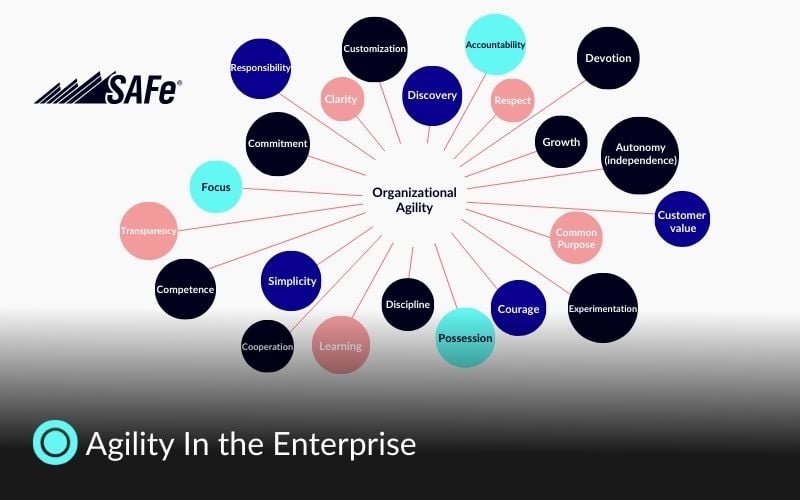What is the meaning of agility?
The definition of agility describes an approach or a system of thought. There are various frameworks and methodologies that underlie this approach and allow agility to be tailored to the organization.
Agile is a set of values and principles originally intended for Project Management and based on the Agile Manifesto. The Agile methodology is a philosophy that focuses on collaborating with customers and providing early feedback. In this way, agility enables rapid and efficient high-level changes.
The Prehistory of Agility - What Does Agile Mean?
The "lean mentality" is the basis of agility and dates back to the 1950s and the Toyota Production System (TPS). In 1986, the article "The New New Product Development Game" in the Harvard Business Review was published by two Japanese Academics, Hirotaka Takeuchi, and Ikujiro Nonaka, In this article, they examined fast-producing examples and adopted a team-oriented approach Fuji-Xerox used this approach to influence the design and development processes of Honda and Canon products.
In 1993, a software company called Easel Corporation wanted to make a complete overhaul of their old products as quickly as possible. They sought help from Jeff Sutherland, the co-founder of Scrum. Jeff Sutherland, who did a lot of research and interviews during this time and received a lot of feedback on this, found that daily team meetings increased productivity significantly. He observed that the projects thus developed were completed with less budget and better quality.
In 1995, Jeff Sutherland collaborated with colleague Ken Schwaber and turned their work into an article entitled "Scrum."
In 2001, 17 software developers - all experts in their fields - came together in Utah to share their ideas. In addition to the founders of Scrum, Jeff Sutherland, and Ken Schwaber, there were also supporters of the methods of frameworks such as Extreme Programming (XP), Crystal, Adaptive Software Development (ASD), Feature-Driven Development (FDD), and Dynamic Systems Development Method (DSDM) and together created the Agile Manifesto.
The Agile Manifesto
Agile working as a definition describes a way of thinking and was born with the Agile Manifesto. The aim of the meeting of 17 experts was to evaluate different experiences and approaches to increasing efficiency in software development processes.
The classic approaches worked well in stable environments, but when the software markets started to change rapidly and unpredictably, they became useless and led to the failure of the project. In order to further develop and improve this approach, a 2-day workshop was held in Utah in 2001 and the "Agile Manifesto", which forms the basis of the term agility management, was then published.
The Agile Manifesto consists of four core values and 12 principles that guide the agile approach to software development.
4 Core Values of Agility
1- Focus on individuals and interactions, not processes or tools.
2- Focus on working software instead of concentrating on comprehensive documentation.
3- Focus on working with the customer instead of contract negotiations.
4- Instead of sticking to a plan, it makes more sense to react to changes
The 12 Principles of the Agile Manifesto are:
- The first priority is to ensure customer satisfaction by providing software early and continuously.
- Changing requirements must also be met at the end of the development process and the customer's competitive advantage must not be lost.
- The software should be delivered at short notice and if improvements are to continue, a short-term version should be made.
- The most effective way to share knowledge in a team is face-to-face.
- Business people and software developers should work together daily throughout the project.
- Only build projects with motivated people and give them the environment and support they need.
- Working software is the primary measure of progress.
- Agile processes to support a consistent pace of development
- Constant focus on technical excellence and good design increases business agility.
- Simplicity - the art of maximizing the amount of work not done - is essential.
- The best architectures, requirements, and designs emerge from self-organizing teams.
- Periodically, the team evaluates how they can become more effective and then refines their work accordingly.
Agility at scale is not an innate ability. It's a skill anyone can learn and develop who is willing to work on themselves. Agility means focusing on the customer and their needs, developing solutions for them, and ultimately creating added value for customers.
Agile teams in companies are teams that react flexibly and quickly to changes. They adapt quickly during the development of a solution or changes such as customer needs, technologies, and market conditions.
They try to add value to the ecosystem under all circumstances. One of their most important properties is value optimization. This keeps the risk of wasting resources under control.
That's why organizations are clinging tightly to agility to deal with change. Not wasting opportunities generously, controlling risks as effectively as possible, and improving your competitiveness - all this brings agility to companies.
Agility - conditions for agile approaches
Strong team spirit: With all agile approaches, the team is more important than the individual. The ability to reflect this team spirit becomes important without forgetting that they are part of a whole.
Fast and continuous delivery: With agile approaches, products should be brought to market continuously. So every product is used by customers and can be improved by customer feedback. This will increase the productivity and quality of the institutions.
Furthermore, adding additional features to the product on a regular basis increases both the addition of the right features that the market needs and the speed of bringing the products to market.
Frequent feedback: No clear decisions can be made without customer and user testing of the final product. For this reason, it is extremely important to collect frequent feedback from the customer and the user. If this is not done, expectations may not be met and, in the worst case, it can lead to the established plan being completely thrown off balance.
Adaptation: One of the most important characteristics of agile approaches is that they can quickly adapt to changes. Especially today, there is an intensely competitive environment in many industries. Agility means that customer requests should also be accepted in the last phase of the process.
Further Characteristics of Agility
- Agility is an approach that adapts quickly to changing conditions based on customer feedback and focuses on generating value through a secure project development approach in short intervals.
- Agility is a set of values and principles (Agile Manifesto).
- Agility is not a goal to be achieved, but an approach aimed at improving every day.
- Short planned cycles give the organization the flexibility to respond to changing requirements and sudden differences.
- Customers actively provide feedback to develop the product and solve problems easily.
- Communication established through prioritizing team participation enables faster problem-solving.
- Any problem that arises during rapid project progress is used as a springboard for a better solution in the next cycle.
Use agility in project management
In classic project management processes, all of the customer's needs and inquiries are received at the beginning of the project. This method, which is suitable for projects whose needs have been identified in detail, is not suitable for projects with possible changes in needs that may arise during project development. Classic project development models are:
● Waterfall model
● Spiral model
● V model
● Incremental model
In order to eliminate the disadvantages of classic project management, the principles and values of agility have started to be used in project management. Organizations have primarily started using the agile mindset in their projects to respond faster to customer requests and market changes, offer higher-quality software, and gain a significant competitive advantage. Agile project management methodologies are designed to facilitate flexibility and responsiveness to changing conditions with minimal documentation.
Comparing agile project management with classic project management shows that the most important difference lies in the planning phase. In agile project management, less time is devoted to the planning phase and more flexibility is used in the project life cycle processes. Mature and flexible processes and an interactive organizational structure form the basic aspects of agile project management. Project success criteria are standards used by stakeholders to determine if the project meets their expectations.
According to this, Agile processes can be expressed as processes that adopt the above values and principles, accept the Agile Manifesto, and create their working methods with an Agile approach. Over time, various agile process frameworks have emerged that implement the agile mindset.
Many of these processes have occurred after the Agility directive. However, some frameworks were also used before the agile statement, such as Scrum. The main types of agile frameworks that are widely used today are the following:
The most popular agile frameworks built for teams
➢ Scrum: This is the framework most commonly used by teams. In addition, it is used in many industries far beyond the limits of agile software development.
The Scrum Team (up to 10 people) works in short iterations (sprints) of 1 to 4 weeks. At the end of the sprint, the study results are presented to receive feedback from stakeholders and users. The Product Owner / Product Manager prioritizes tasks while the Scrum Master offers to coach.
The team ensures the implementation of the Scrum process. Developers work on the implementation of priority tasks. Every Scrum starts with a sprint and ends with a review and a retrospective. This makes Scrum a viable agile process model and an agile project method for the development of new products and services.
Other frameworks for teams are:
- Kanban
- Extreme Programming (XP)
Featured Resource
Top Agile Frameworks in Software Engineering for 2024
The most popular agile frameworks in Agile at Scale are:
➢ SAFe (Scaled Agile Framework): This is a method for managing and executing large, complex projects using Agile practices. It provides a framework for coordinating and aligning multiple Agile teams and helps organizations scale their Agile processes to deliver enterprise-level software and systems.
The SAFe includes practices for program and portfolio management and guidance for teams and individuals to help them work together more effectively. The framework is based on the principles of the Agile Manifesto and is designed to be flexible and adaptable to the specific needs of different organizations.
Other scaled agility frameworks are:
- LeSS (Large Scale Scrum)
- SoS (Scrum of Scrums)
- DAD (Disciplined Agile Delivery)
As today's technology adopts a more flexible methodology, it can be seen that the rate of development of software and other products using agility methods has increased compared to previous years. The 17th Agile Status Report shows that 80% of software development teams will use agile project management approaches in 2022. It seems that the most popular agile frameworks are Scrum and SAFe (Scaled Agile Framework).
What is agility not?
It can often be observed that from time to time completely different definitions are made instead of the concept of agility. For example, the concept of scrum is used instead of agility. It's important to understand Agile vs. Scrum difference so there's no confusion.
Scrum is a proprietary methodology based on Agile principles but with its own roles, events, and artifacts. It is also important to know that agility is not a magic wand that fixes the problems in the way we currently work. Agility cannot be reduced to a single method, goal, standard tools, or post. It is a philosophy that encourages working in a focused way on all projects.
Embrace Agility
It would not be an exaggeration to say that agility has started a revolution. The agile approach has greatly increased success rates in project development over the past 20 years, ensuring improved quality and faster time to market. In addition, agility increases the motivation and productivity of the project teams to the maximum.
The Agile approach, which represents a radical alternative to command-and-command management with new values, principles, practices, and benefits, is spreading at breakneck speed across a wide range of sectors. The Agile approach not only accelerates profitable growth by moving employees out of their comfort zones and into self-directed, customer-centric, multidisciplinary teams but also creates a new generation of talented employees.
At this point, it would be important to mention that regardless of which agile framework or approaches a company uses: whether SAFe (Scaled Agile Framework), Scrum, or Kanban, they are only tools and are only intended for more focus, more transparency, and for a better collaboration. These tools only show how well you can convert the needs of employees and customers into added value or how you can achieve this in an improved form.
However, these tools are not designed to do all the work themselves, nor do they create the necessary environment to increase agility and develop teams. For this, it is important to fully acquire the values and principles of the agile mindset to complete the necessary training and get on the road.
Organizational Agility
Organizational agility basically means redesigning the structural and process organization. Agility succeeds through structures and cultures. Of course, it is a long way from a hierarchical organizational structure to a decentralized network organization.
Organizational agility is an organization's ability to adapt to new conditions and change direction.z The goal of an agile transformation is to create an agile organization that is compatible with corporate strategies, can adapt quickly, learn new things, and constantly produce added value.
Agile organizations have the following basic characteristics:
- Authority: There is a distributed flow of information and control. Much less authority (title, position), which means that there is less dependence on authorities. Project-based authorization is available and as the project changes, the authorization also changes.
- Rules and Procedures: Procedures involve fewer rules. There is little formal regulation, particularly in job descriptions and work programs. In addition, fluid role definitions apply.
- Coordination: Informal and individual coordination is seen. Communication has improved in terms of coordination. A goal-oriented vote takes place.
- Structure: There are cross-functional connections with teamwork. The boundaries between the units are flexible.
- Personnel management: Employees are empowered and employee participation is in the foreground. Autonomy only applies to decision-making. Access to knowledge and experience is possible. There are multifunctional teams and there is skill training and differentiation as well as diversity development.
Key Considerations for Implementing Agility in Companies:
- Established strong communication with customers and prioritized customer needs when designing and manufacturing products
- Instead of making decisions from a central place within the organizational structure, the functional levels of the company are authorized to make decisions
- Bring flexibility to the organization that allows for rapid changes in production volume
- Careful business analysis
- Creating value for customers should be one of the main goals
- Presence of a well-trained, experienced, and competent workforce in the organization
- Designing an agile organizational culture
Internal agility in companies
As we have already found out, the two most fundamental characteristics of agile companies are that they are flexible and fast. While quickness refers to the speed at which work gets done, flexibility is the ability to adapt to changes in the environment.
Agility, therefore, means working quickly and adapting quickly to changes in the environment. Consequently, agility means being fast and flexible in equal measure. But speed also refers to quickly pursuing opportunities, solving problems, and responding to change. The time it takes to complete an order, the time to respond to a customer complaint, the time to give manager approval for a purchase, and the time to make an investment decision describe the situations in relation to speed.
On the other hand, flexibility is the ability to anticipate the differences in the market and quickly adapt to new conditions and customer expectations. The development of methods of coping with sudden changes in market conditions, giving the customer the right to choose the characteristics of the product he wants to buy, is related to the concept of flexibility.
Agile companies, with their passionate bosses, dynamic employees, and flexible structures, consequently have the ability to make quick decisions, take immediate action, complete work quickly, and adapt quickly to change.
In an institutional sense, agility can manifest itself in many ways, from product delivery time, speed of response to complaints, flexibility to reorganize when the market changes, and making quick decisions in exceptional situations. In an agile company, the will to complete the work and the positive energy of the employees make the difference.
No agility in companies
Companies that have chosen the traditional approach, on the other hand, have a different structure, culture, and way of working than agile companies. These companies have a repetitive, strictly hierarchical structure and a stable culture.
In a company you see that market conditions are changing, things are not the way they used to be and something new is needed to survive in the new conditions the price of not being able to achieve this change can be for a company to become expensive.
Profits created by agility management
Both the pace of change and transformation is increasing rapidly. Keeping up with this acceleration of change is no longer an option, but a necessity for companies to keep their businesses healthy. At this point, organizations that have embraced agility and focus on producing the most valuable output in the least amount of time by making quick decisions are one step ahead.
The 16th Agile Status Report gathered insights from over 3,000 people in the Agile community in 2022, revealing the top factors that contribute to satisfaction with Agile practices. According to the report:
- 69% of respondents experience increased collaboration, making teamwork more effective.
- 54% find better alignment with business needs, ensuring that projects are more relevant.
- 39% report a better work environment, enhancing overall job satisfaction.
These statistics validate that more organizations are scaling Agile across the enterprise to achieve digital transformation. The focus on Agile tools and methodologies specifically for software development also enhances visibility in the application development lifecycle.
In addition, it is very clear that agility is not only limited to the software industry but continues to spread rapidly to many different industries. The report shows that while software development remains the main area for the adoption of agility, other areas such as IT, operations, and marketing are also beginning to adopt agility.
Among other things, the report notes that Scrum is the most widely used framework by teams, and SAFe (Scaled Agile Framework) continues to be the leader in scaling agility.
Conclusion
In summary, enterprise agility is becoming increasingly important to succeed in today's fast-paced business world. By using agile methods, companies can react faster to changes, better meet customer needs, and drive innovation.
On our "Scaled Agile Framework" page you will find various courses that can help you to introduce and implement agile working in your company. For example, you can take the "SAFe Agilist" course, which teaches you the basics of SAFe and prepares you for the SAFe Agilist certification. In addition, we also offer the "SAFe for Teams" course, which helps team members to be more effective in their work within SAFe.
Take a look at our "Academy" page to continue your education. Here you will find a wide range of training courses and certifications on various IT topics, including agile working. We look forward to helping you achieve your career goals!
Credentials
- Agile Alliance. (2023). The State of Agile Report. https://stateofagile.com/
- Harvard Business Review. (2016, May 17). Introducing agile working methods [blog post]. https://hbr.org/2016/05/embracing-agile
- Scaled Agile, Inc. (n.d.). Scaled Agile Framework. https://www.scaledagileframework.com/
- Scaled Agile, Inc. (2023). Scaling Agile [website]. https://scaledagile.com/
- Scrum.org. (n.d.). scrum https://www.scrum.org/





